‘They are preparing for war’: An expert on civil wars discusses where political extremists are taking this country
Barbara F. Walter, 57, is a political science professor at the University of California at San Diego and the author of “How Civil Wars Start: And How to Stop Them,” which was released in January. She lives in San Diego with her husband.
Having studied civil wars all over the world, and the conditions that give rise to them, you argue in your book, somewhat chillingly, that the United States is coming dangerously close to those conditions. Can you explain that?
So we actually know a lot about civil wars — how they start, how long they last, why they’re so hard to resolve, how you end them. And we know a lot because since 1946, there have been over 200 major armed conflicts. And for the last 30 years, people have been collecting a lot of data, analyzing the data, looking at patterns. I’ve been one of those people.
We went from thinking, even as late as the 1980s, that every one of these was unique. And the way people studied it is they would be a Somalia expert, a Yugoslavia expert, a Tajikistan expert. And everybody thought their case was unique and that you could draw no parallels. Then methods and computers got better, and people like me came and could collect data and analyze it. And what we saw is that there are lots of patterns at the macro level.
In 1994, the U.S. government put together this Political Instability Task Force. They were interested in trying to predict what countries around the world were going to become unstable, potentially fall apart, experience political violence and civil war.
Was that out of the State Department?
That was done through the CIA. And the task force was a mix of academics, experts on conflict, and data analysts. And basically what they wanted was: In all of your research, tell us what you think seems to be important. What should we be considering when we’re thinking about the lead-up to civil wars?
Originally the model included over 30 different factors, like poverty, income inequality, how diverse religiously or ethnically a country was. But only two factors came out again and again as highly predictive. And it wasn’t what people were expecting, even on the task force. We were surprised. The first was this variable called anocracy. There’s this nonprofit based in Virginia called the Center for Systemic Peace. And every year it measures all sorts of things related to the quality of the governments around the world. How autocratic or how democratic a country is. And it has this scale that goes from negative 10 to positive 10. Negative 10 is the most authoritarian, so think about North Korea, Saudi Arabia, Bahrain. Positive 10 are the most democratic. This, of course, is where you want to be. This would be Denmark, Switzerland, Canada. The U.S. was a positive 10 for many, many years. It’s no longer a positive 10. And then it has this middle zone between positive 5 and negative 5, which was you had features of both. If you’re a positive 5, you have more democratic features, but definitely have a few authoritarian elements. And, of course, if you’re negative 5, you have more authoritarian features and a few democratic elements. The U.S. was briefly downgraded to a 5 and is now an 8.
And what scholars found was that this anocracy variable was really predictive of a risk for civil war. That full democracies almost never have civil wars. Full autocracies rarely have civil wars. All of the instability and violence is happening in this middle zone. And there’s all sorts of theories why this middle zone is unstable, but one of the big ones is that these governments tend to be weaker. They’re transitioning to either actually becoming more democratic, and so some of the authoritarian features are loosening up. The military is giving up control. And so it’s easier to organize a challenge. Or, these are democracies that are backsliding, and there’s a sense that these governments are not that legitimate, people are unhappy with these governments. There’s infighting. There’s jockeying for power. And so they’re weak in their own ways. Anyway, that turned out to be highly predictive.
And then the second factor was whether populations in these partial democracies began to organize politically, not around ideology — so, not based on whether you’re a communist or not a communist, or you’re a liberal or a conservative — but where the parties themselves were based almost exclusively around identity: ethnic, religious or racial identity. The quintessential example of this is what happened in the former Yugoslavia.
So for you, personally, what was the moment the ideas began to connect, and you thought: Wait a minute, I see these patterns in my country right now?
My dad is from Germany. He was born in 1932 and lived through the war there, and he emigrated here in 1958. He had been a Republican his whole life, you know; we had the Reagan calendar in the kitchen every year.
And starting in early 2016, I would go home to visit, and my dad — he doesn’t agitate easily, but he was so agitated. All he wanted to do was talk about Trump and what he was seeing happening. He was really nervous. It was almost visceral — like, he was reliving the past. Every time I’d go home, he was just, like, “Please tell me Trump’s not going to win.” And I would tell him, “Dad, Trump is not going to win.” And he’s just, like, “I don’t believe you; I saw this once before. And I’m seeing it again, and the Republicans, they’re just falling in lockstep behind him.” He was so nervous.
I remember saying: “Dad, what’s really different about America today from Germany in the 1930s is that our democracy is really strong. Our institutions are strong. So, even if you had a Trump come into power, the institutions would hold strong.” Of course, then Trump won. We would have these conversations where my dad would draw all these parallels. The brownshirts and the attacks on the media and the attacks on education and on books. And he’s just, like, I’m seeing it. I’m seeing it all again here. And that’s really what shook me out of my complacency, that here was this man who is very well educated and astute, and he was shaking with fear. And I was like, Am I being naive to think that we’re different?
That’s when I started to follow the data. And then, watching what happened to the Republican Party really was the bigger surprise — that, wow, they’re doubling down on this almost white supremacist strategy. That’s a losing strategy in a democracy. So why would they do that? Okay, it’s worked for them since the ’60s and ’70s, but you can’t turn back demographics. And then I was like, Oh my gosh. The only way this is a winning strategy is if you begin to weaken the institutions; this is the pattern we see in other countries. And, as an American citizen I’m like, These two factors are emerging here, and people don’t know.
So I gave a talk at UCSD about this — and it was a complete bomb. Not only did it fall flat, but people were hostile. You know, How dare you say this? This is not going to happen. This is fearmongering. I remember leaving just really despondent, thinking: Wow, I was so naive to think that, if it’s true, and if it’s based on hard evidence, people will be receptive to it. You know, how do you get the message across if people don’t want to hear it? If they’re not ready for it.
I didn’t do a great job framing it initially, that when people think about civil war, they think about the first civil war. And in their mind, that’s what a second one would look like. And, of course, that’s not the case at all. So part of it was just helping people conceptualize what a 21st-century civil war against a really powerful government might look like.
After January 6th of last year, people were asking me, “Aren’t you horrified?” “Isn’t this terrible?” “What do you think?” And, first of all, I wasn’t surprised, right? People who study this, we’ve been seeing these groups have been around now for over 10 years. They’ve been growing. I know that they’re training. They’ve been in the shadows, but we know about them. I wasn’t surprised.
The biggest emotion was just relief, actually. It was just, Oh my gosh, this is a gift. Because it’s bringing it out into the public eye in the most obvious way. And the result has to be that we can’t deny or ignore that we have a problem. Because it’s right there before us. And what has been surprising, actually, is how hard the Republican Party has worked to continue to deny it and to create this smokescreen — and in many respects, how effective that’s been, at least among their supporters. Wow: Even the most public act of insurrection, probably a treasonous act that 10, 20 years ago would have just cut to the heart of every American, there are still real attempts to deny it. But it was a gift because it brought this cancer that those of us who have been studying it, have been watching it growing, it brought it out into the open.
Does it make you at all nervous when you think about the percentage of people who were at, say, January 6th who have some military or law enforcement connection?
Yes. The CIA also has a manual on insurgency. You can Google it and find it online. Most of it is not redacted. And it’s absolutely fascinating to read. It’s not a big manual. And it was written, I’m sure, to help the U.S. government identify very, very early stages of insurgency. So if something’s happening in the Philippines, or something’s happening in Indonesia. You know, what are signs that we should be looking out for?
And the manual talks about three stages. And the first stage is pre-insurgency. And that’s when you start to have groups beginning to mobilize around a particular grievance. And it’s oftentimes just a handful of individuals who are just deeply unhappy about something. And they begin to articulate those grievances. And they begin to try to grow their membership.
The second stage is called the incipient conflict stage. And that’s when these groups begin to build a military arm. Usually a militia. And they’d start to obtain weapons, and they’d start to get training. And they’ll start to recruit from the ex-military or military and from law enforcement. Or they’ll actually — if there’s a volunteer army, they’ll have members of theirs join the military in order to get not just the training, but also to gather intelligence.
And, again, when the CIA put together this manual, it’s about what they have observed in their experience in the field in other countries. And as you’re reading this, it’s just shocking the parallels. And the second stage, you start to have a few isolated attacks. And in the manual, it says, really the danger in this stage is that governments and citizens aren’t aware that this is happening. And so when an attack occurs, it’s usually just dismissed as an isolated incident, and people are not connecting the dots yet. And because they’re not connecting the dots, the movement is allowed to grow until you have open insurgency, when you start to have a series of consistent attacks, and it becomes impossible to ignore.
And so, again, this is part of the process you see across the board, where the organizers of insurgencies understand that they need to gain experienced soldiers relatively quickly. And one way to do that is to recruit. Here in the United States, because we had a series of long wars in Afghanistan and Iraq and Syria, and now that we’ve withdrawn from them, we’ve had more than 20 years of returning soldiers with experience. And so this creates a ready-made subset of the population that you can recruit from.
What do you say to people who charge that this is all overblown, that civil war could never happen here in the United States — or that you’re being inflammatory and making things worse by putting corrosive ideas out there?
Oh, there’s so many things to say. One thing is that groups — we’ll call them violence entrepreneurs, the violent extremists who want to tear everything down and want to institute their own radical vision of society — they benefit from the element of surprise, right? They want people to be confused when violence starts happening. They want people to not understand what’s going on, to think that nobody’s in charge. Because then they can send their goons into the streets and convince people that they’re the ones in charge. Which is why when I would talk to people who lived through the start of the violence in Sarajevo or Baghdad or Kyiv, they all say that they were surprised. And they were surprised in part because they didn’t know what the warning signs were.
But also because people had a vested interest in distracting them or denying it so that when an attack happened, or when you had paramilitary troops sleeping in the hills outside of Sarajevo, they would make up stories. You know, “We’re just doing training missions.” Or “We’re just here to protect you. There’s nothing going on here. Don’t worry about this.”
I wish it were the case that by not talking about it we could prevent anything from happening. But the reality is, if we don’t talk about it, [violent extremists] are going to continue to organize, and they’re going to continue to train. There are definitely lots of groups on the far right who want war. They are preparing for war. And not talking about it does not make us safer.
What we’re heading toward is an insurgency, which is a form of a civil war. That is the 21st-century version of a civil war, especially in countries with powerful governments and powerful militaries, which is what the United States is. And it makes sense. An insurgency tends to be much more decentralized, often fought by multiple groups. Sometimes they’re actually competing with each other. Sometimes they coordinate their behavior. They use unconventional tactics. They target infrastructure. They target civilians. They use domestic terror and guerrilla warfare. Hit-and-run raids and bombs. We’ve already seen this in other countries with powerful militaries, right? The IRA took on the British government. Hamas has taken on the Israeli government. These are two of the most powerful militaries in the world. And they fought for decades. And in the case of Hamas I think we could see a third intifada. And they pursue a similar strategy.
Here it’s called leaderless resistance. And that method of how to defeat a powerful government like the United States is outlined in what people are calling the bible of the far right: “The Turner Diaries,” which is this fictitious account of a civil war against the U.S. government. It lays out how you do this. And one of the things it says is, Do not engage the U.S. military. You know, avoid it at all costs. Go directly to targets around the country that are difficult to defend and disperse yourselves so it’s hard for the government to identify you and infiltrate you and eliminate you entirely.
So, like with the [Charles Dickens’s] ghost of Christmas future, are these the things that will be or just that may be?
I can’t say when it’s going to happen. I think it’s really important for people to understand that countries that have these two factors, who get put on this watch list, have a little bit less than a 4 percent annual risk of civil war. That seems really small, but it’s not. It means that, every year that those two factors continue, the risk increases.
The analogy is smoking. If I started smoking today, my risk of dying of lung cancer or some smoking-related disease is very small. If I continue to smoke for the next 10, 20, 30, 40 years, my risk eventually of dying of something related to smoking is going to be very high if I don’t change my behavior. And so I think that’s one of the actually optimistic things: We know the warning signs. And we know that if we strengthen our democracy, and if the Republican Party decides it’s no longer going to be an ethnic faction that’s trying to exclude everybody else, then our risk of civil war will disappear. We know that. And we have time to do it. But you have to know those warning signs in order to feel an impetus to change them.
This interview has been edited and condensed.
KK Ottesen is a regular contributor to the magazine.
Democracy Dies in Darkness

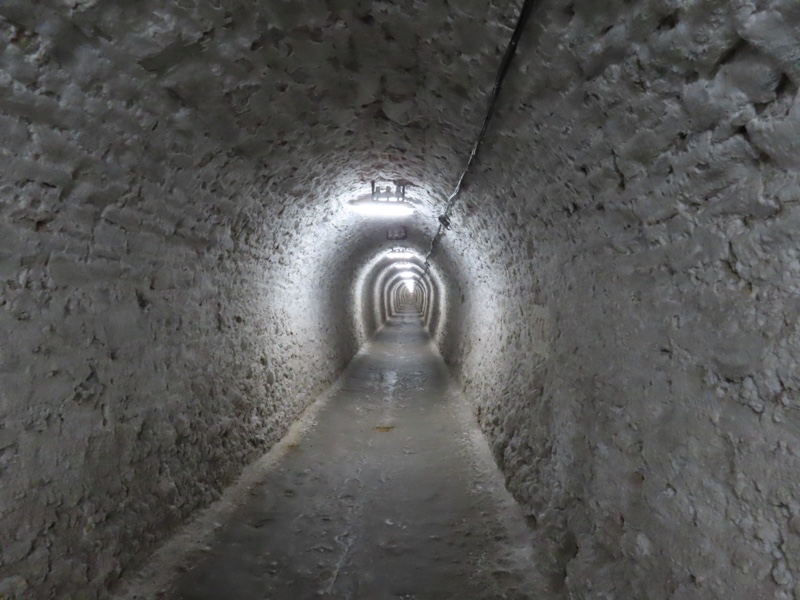
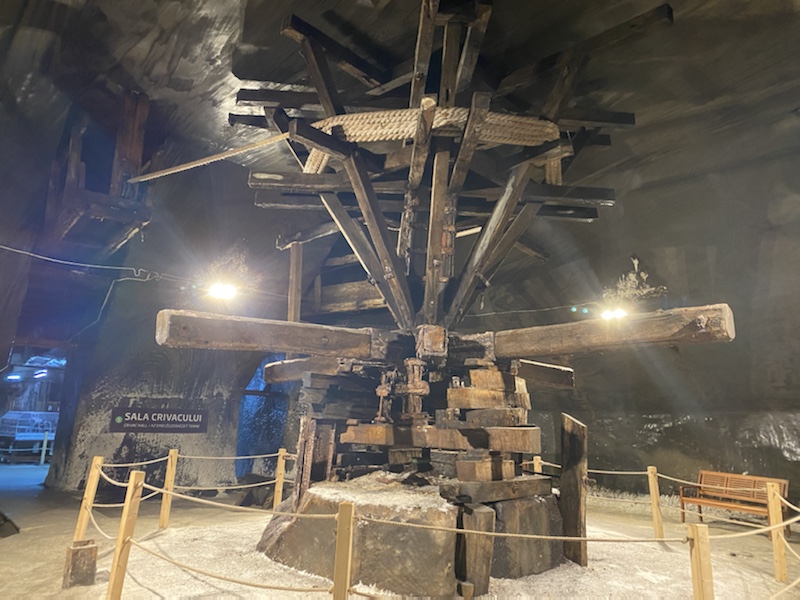
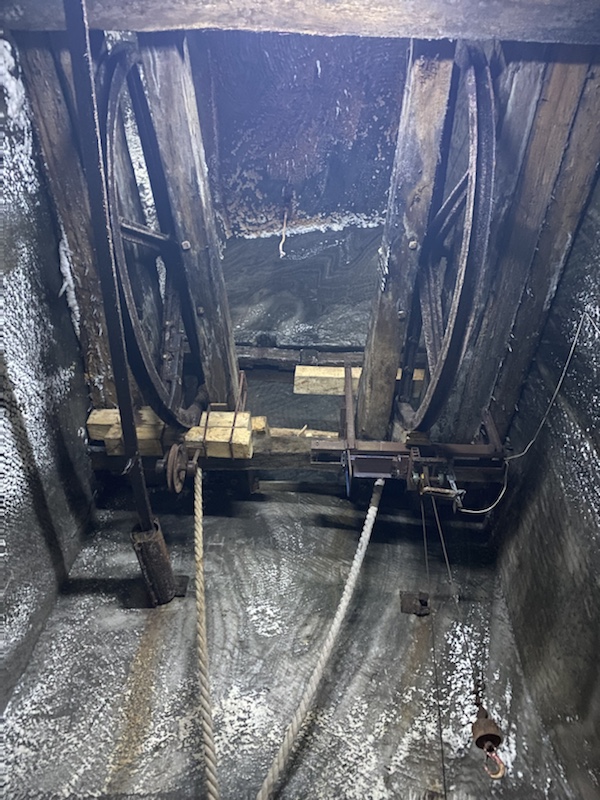
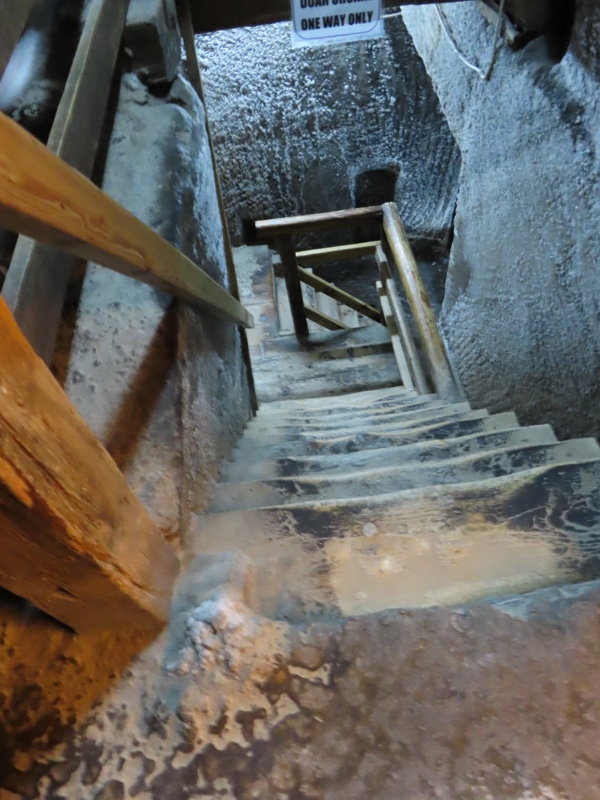
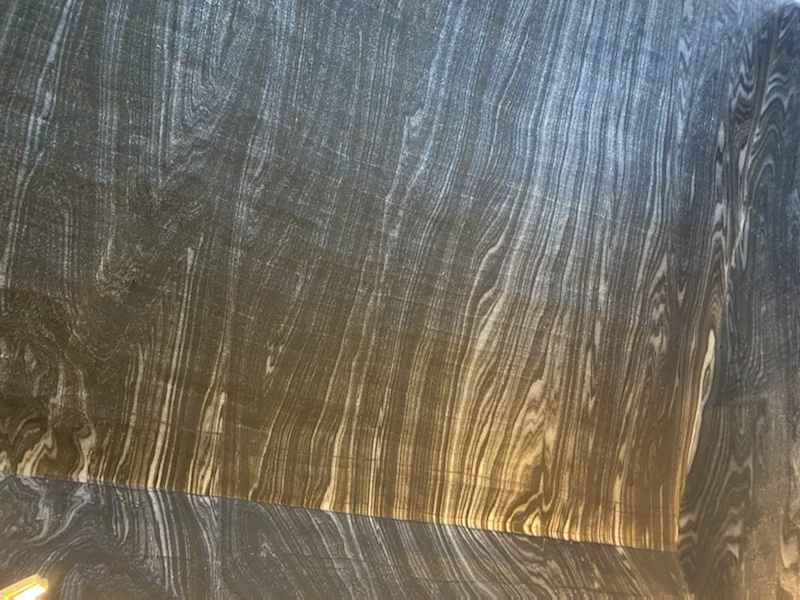



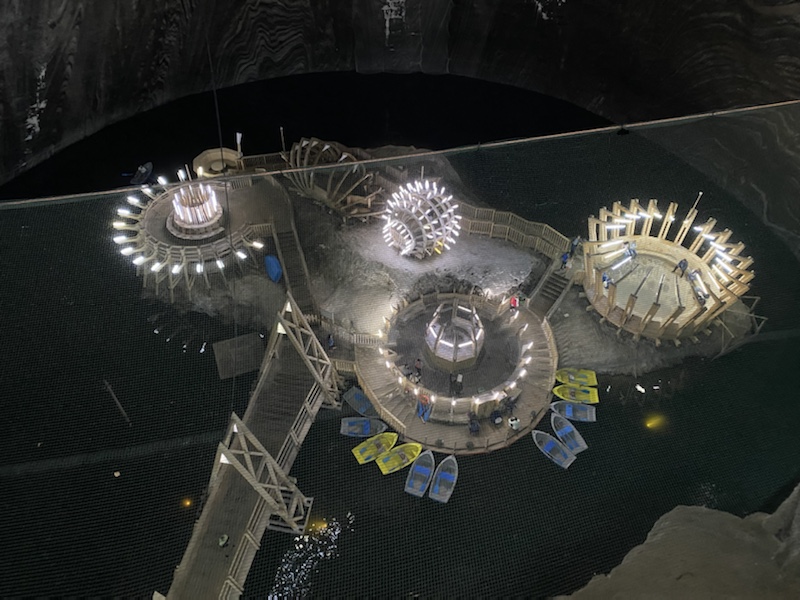
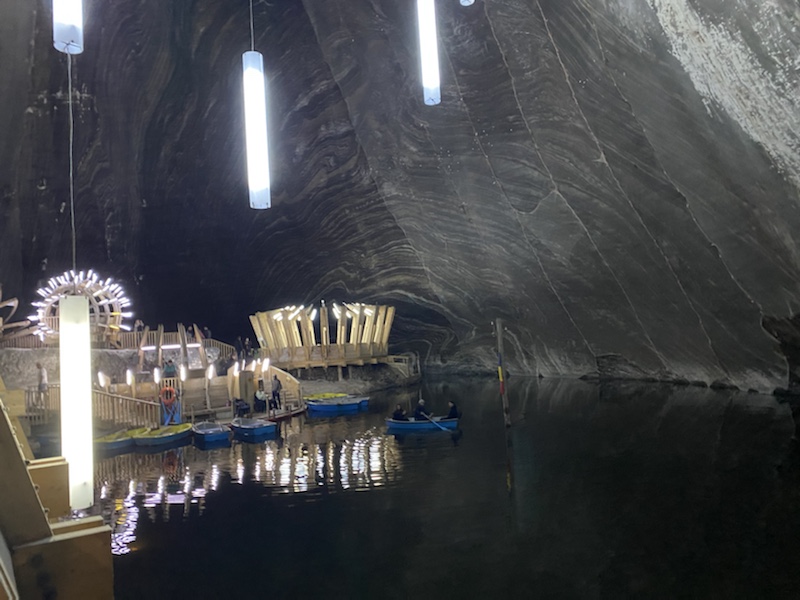 There is even a Ferris wheel down here, an art gallery, a cafe and a gift shop (of course!)
There is even a Ferris wheel down here, an art gallery, a cafe and a gift shop (of course!)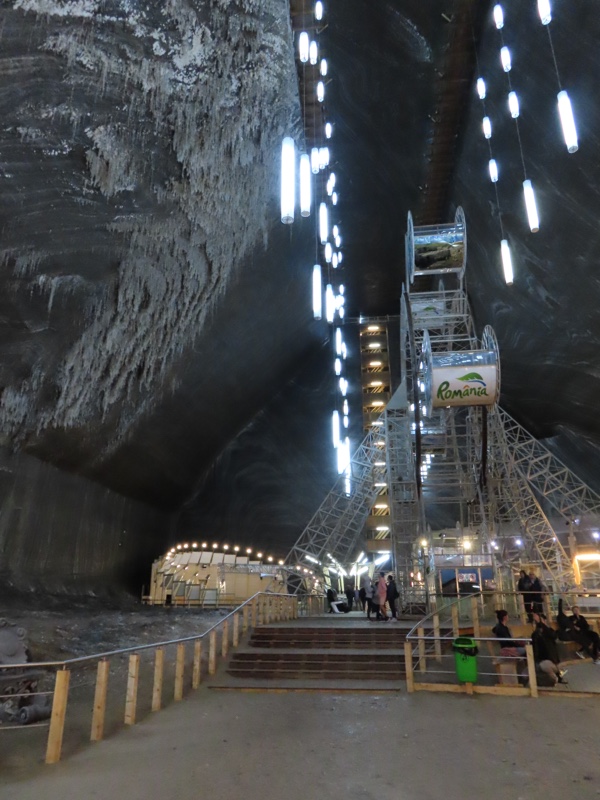
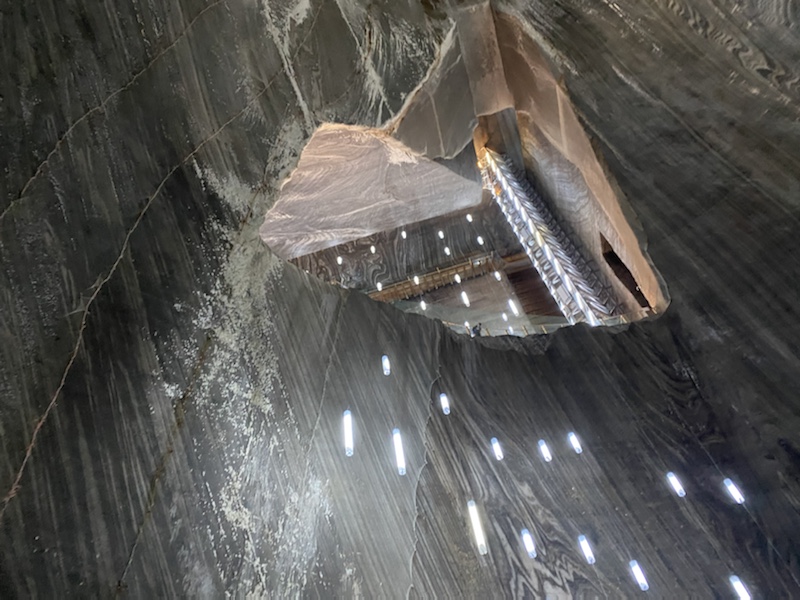
 Thankfully there is also a lift / elevator – if you do find the stairs difficult (and ffs when there is 187 of them, who doesn’t?) you can wait in line for the lift. The lift takes about 35 seconds to get from bottom to top and vice versa and fits only 7 people at a time, so during busy times you could have quite a wait. Thankfully for us, it wasn’t particularly busy this morning and the wait was barely two minutes. There is no mention on Trip Advisor or the website or any bloody google-able page as the existence of this lift… it’s kinda alluded to, but in a ‘you might be able to use it?’ kinda way. So it wasn’t until we got here that I discovered I’d actually be able to go in.
Thankfully there is also a lift / elevator – if you do find the stairs difficult (and ffs when there is 187 of them, who doesn’t?) you can wait in line for the lift. The lift takes about 35 seconds to get from bottom to top and vice versa and fits only 7 people at a time, so during busy times you could have quite a wait. Thankfully for us, it wasn’t particularly busy this morning and the wait was barely two minutes. There is no mention on Trip Advisor or the website or any bloody google-able page as the existence of this lift… it’s kinda alluded to, but in a ‘you might be able to use it?’ kinda way. So it wasn’t until we got here that I discovered I’d actually be able to go in.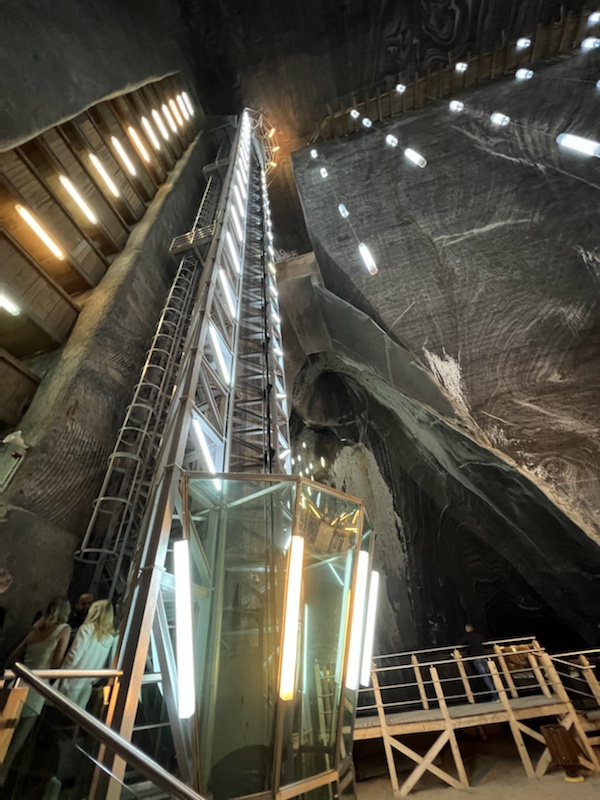

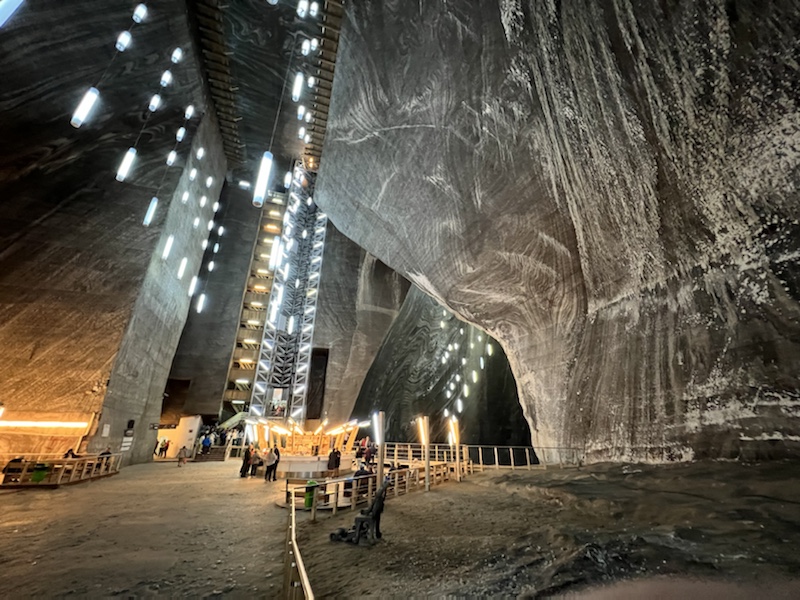
 It sure looks pretty – pretty fantastical that is. The castle was originally designed for this site in the mid-15thC and was partially built between 1440-1446. Building continued on it in 1458-1480 and then there was a huge building spurt on the place in the 17th century and even more done in the 19th century – the result of which is a hodge-podge of ‘architectural improvements’ rather than any determined or cohesive intent to keep building a 15thC castle.
It sure looks pretty – pretty fantastical that is. The castle was originally designed for this site in the mid-15thC and was partially built between 1440-1446. Building continued on it in 1458-1480 and then there was a huge building spurt on the place in the 17th century and even more done in the 19th century – the result of which is a hodge-podge of ‘architectural improvements’ rather than any determined or cohesive intent to keep building a 15thC castle.  There were the obligatory dungeons complete with torture implements which were very easily accessible right at the front of the castle, being directly off the portcullis entrance tower.
There were the obligatory dungeons complete with torture implements which were very easily accessible right at the front of the castle, being directly off the portcullis entrance tower. 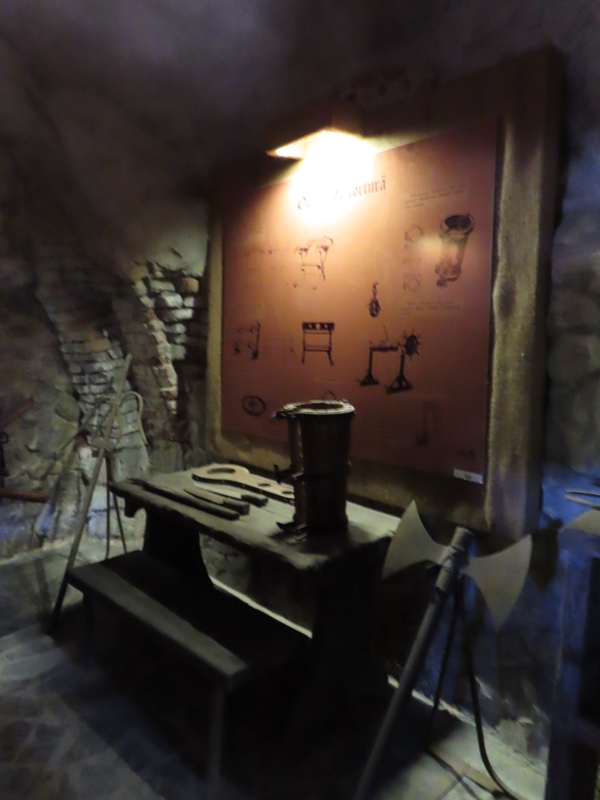
 I don’t know what it is about seeing dummies in medieval castles that immediately sets your expectations for a less than informative visit. That and people dressed in medjieval clothing – which this place had (one guy in Rus pants, a 14thC men’s shirt, a 15th Burgundian pouch and a seax on his belt… should have nabbed his photo). Anyway, it was still fun even if I knew the entire place had burned down in 1876 and the current castle is effectively a fanciful recreation of some modern architect’s idea of what it should look like.
I don’t know what it is about seeing dummies in medieval castles that immediately sets your expectations for a less than informative visit. That and people dressed in medjieval clothing – which this place had (one guy in Rus pants, a 14thC men’s shirt, a 15th Burgundian pouch and a seax on his belt… should have nabbed his photo). Anyway, it was still fun even if I knew the entire place had burned down in 1876 and the current castle is effectively a fanciful recreation of some modern architect’s idea of what it should look like. 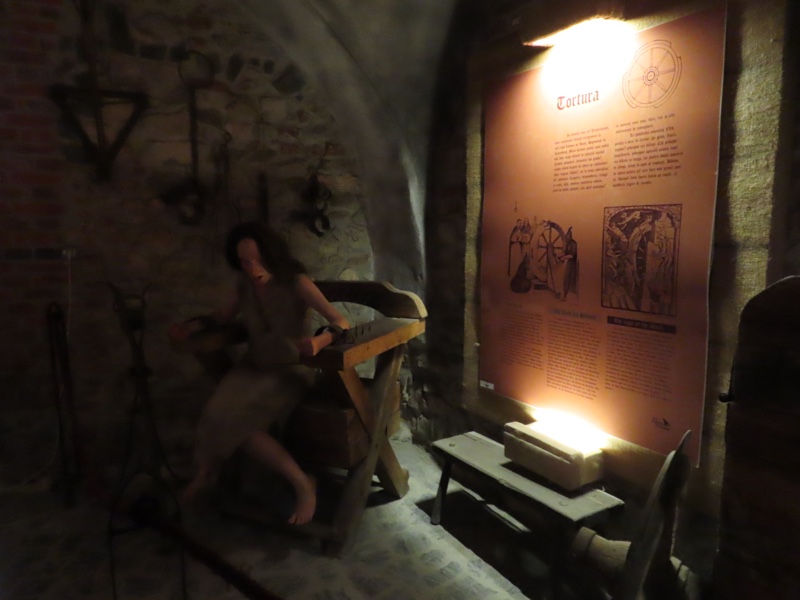
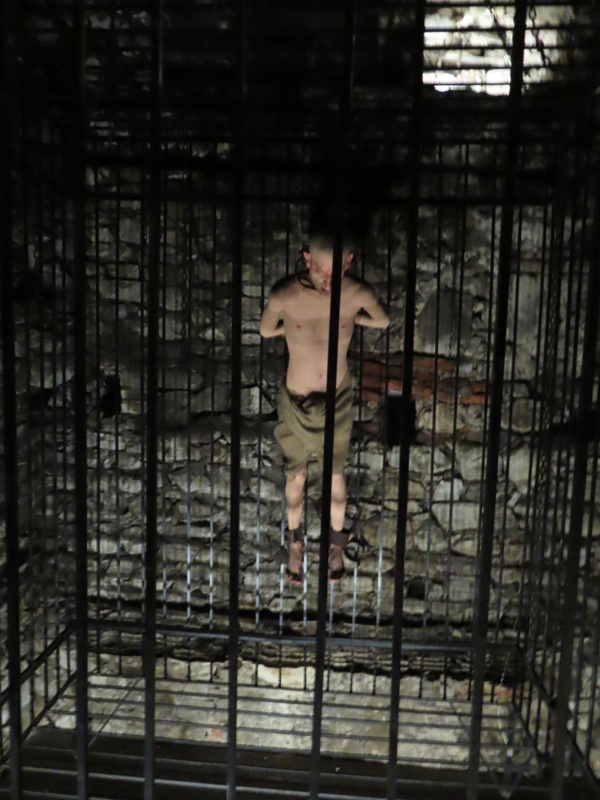 Gothic-Renaissance castle bits ahoy…
Gothic-Renaissance castle bits ahoy…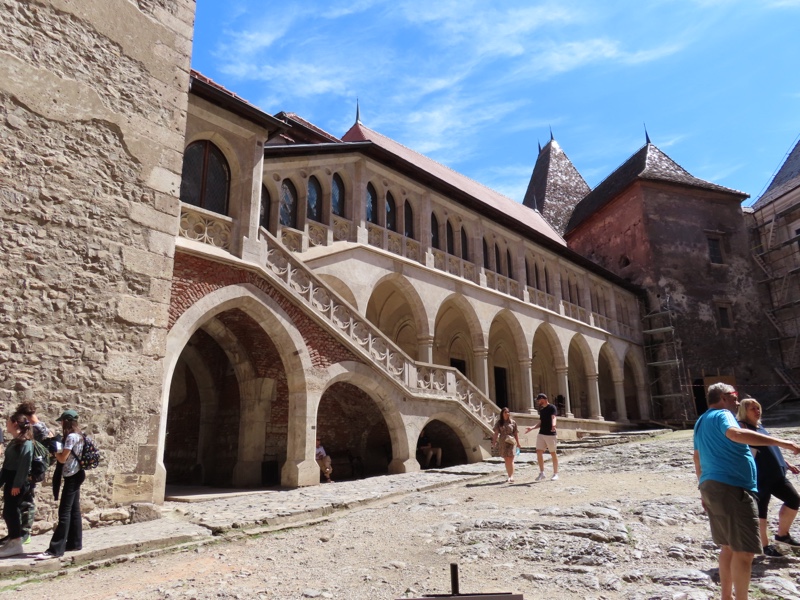
 Turrets and gargoyles…
Turrets and gargoyles…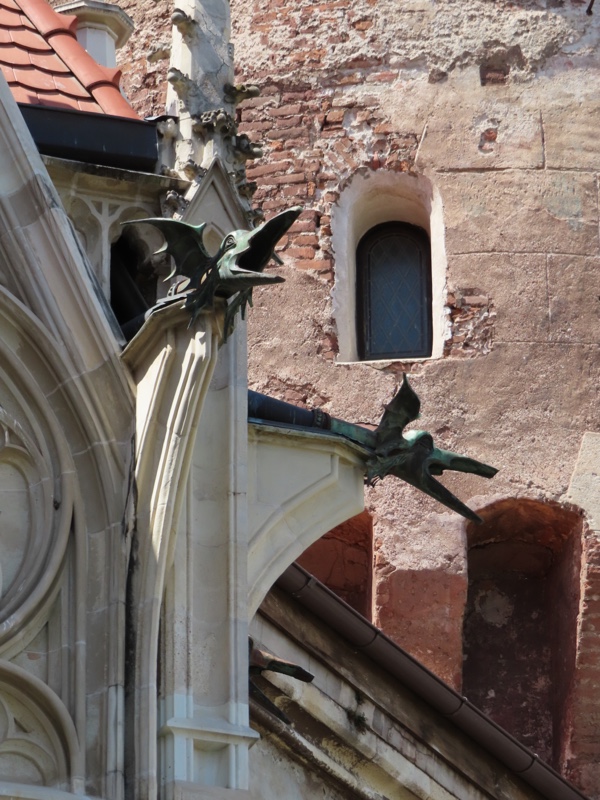

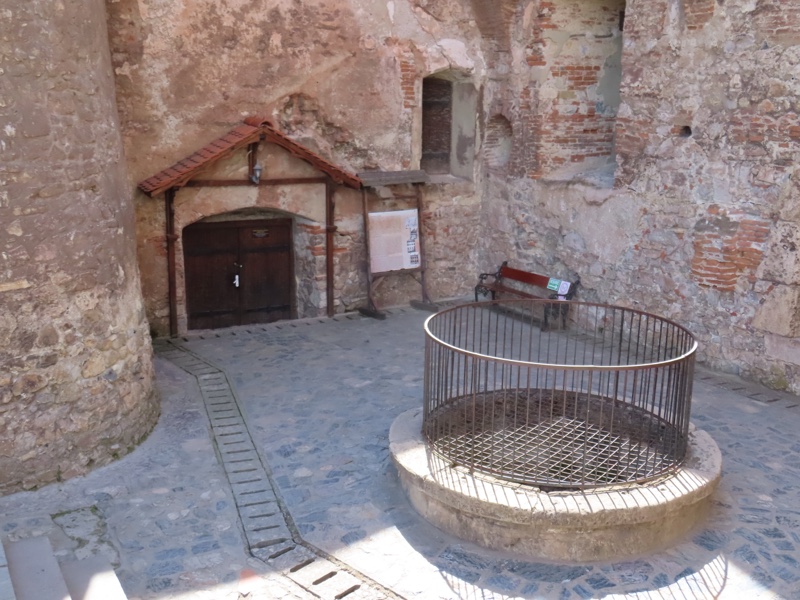

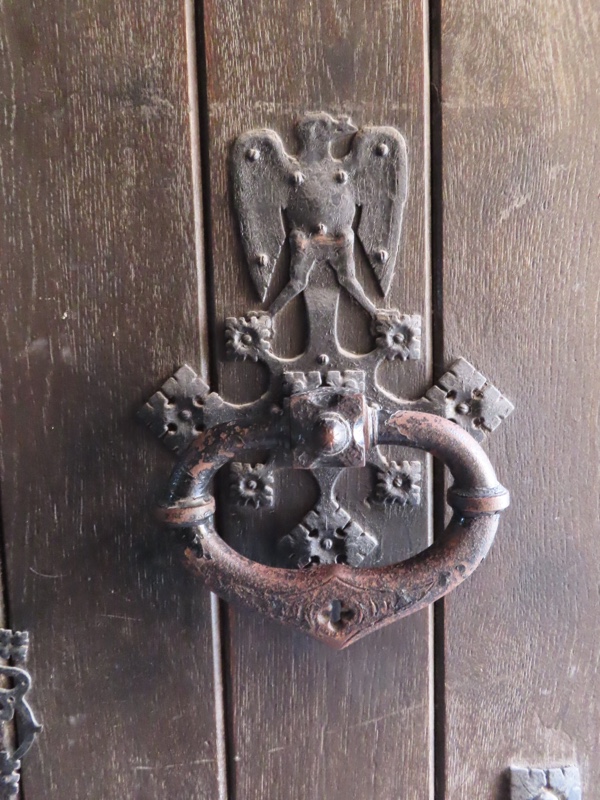
 It’s lovely in here and I imagine it’d be great to hold events etc., but it is so bothersome looking around and knowing very little of it is original or even in keeping with the original plan for the castle.
It’s lovely in here and I imagine it’d be great to hold events etc., but it is so bothersome looking around and knowing very little of it is original or even in keeping with the original plan for the castle. 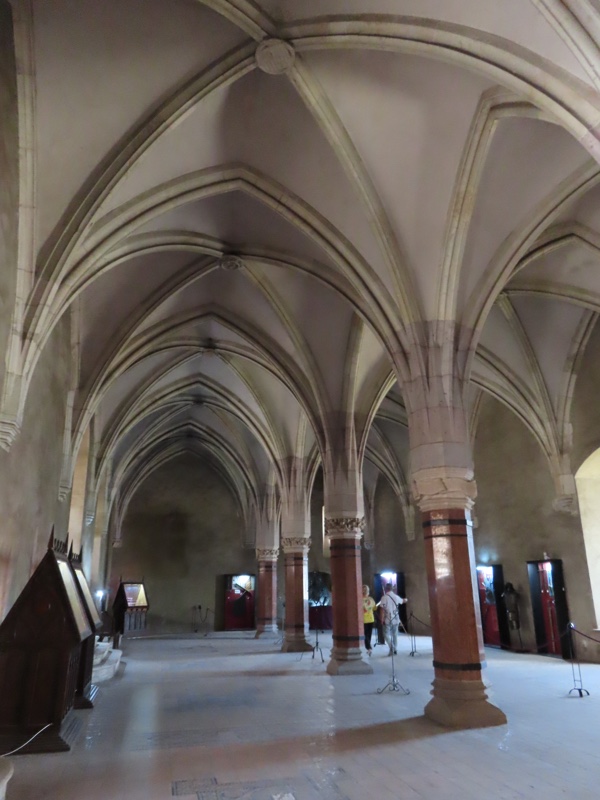
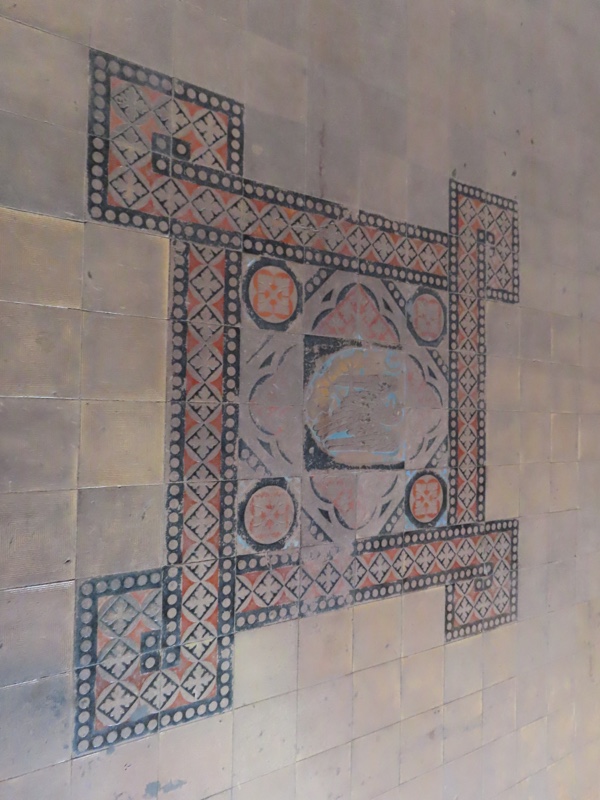
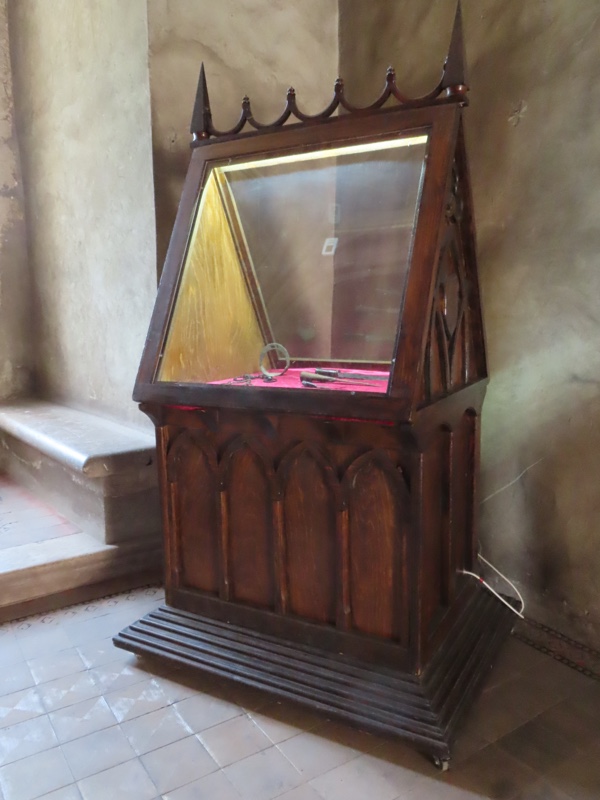
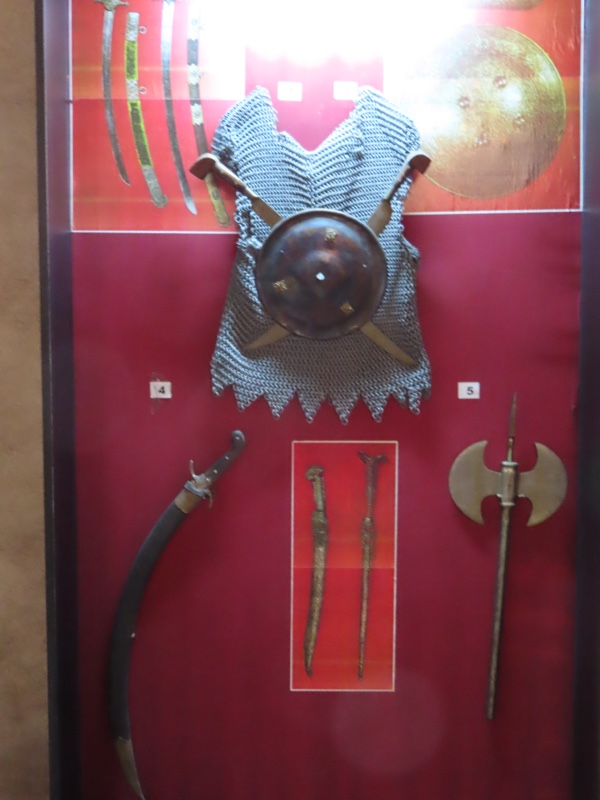

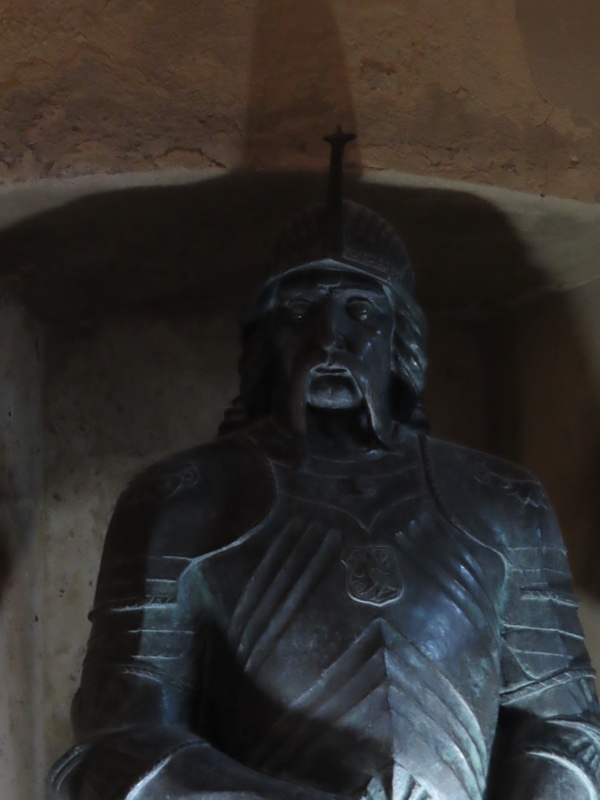 Now this looks like a perfectly SCA throne.
Now this looks like a perfectly SCA throne. 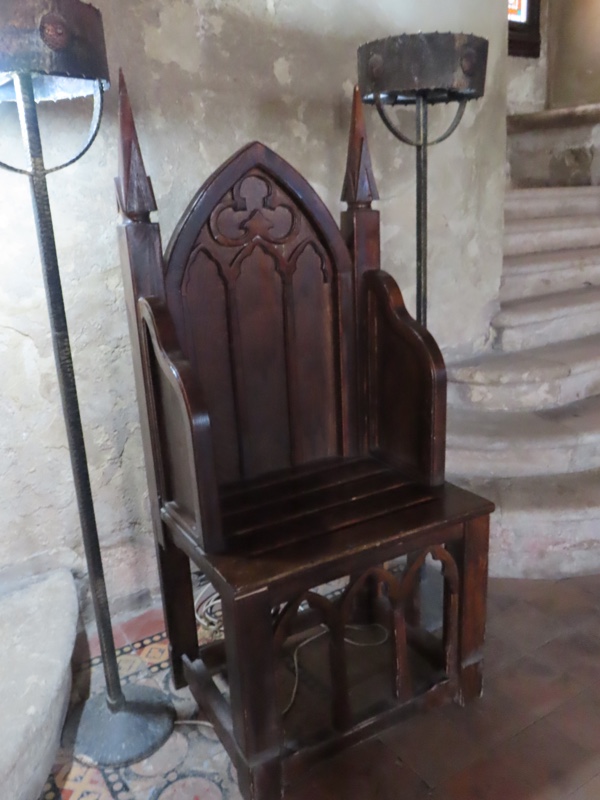















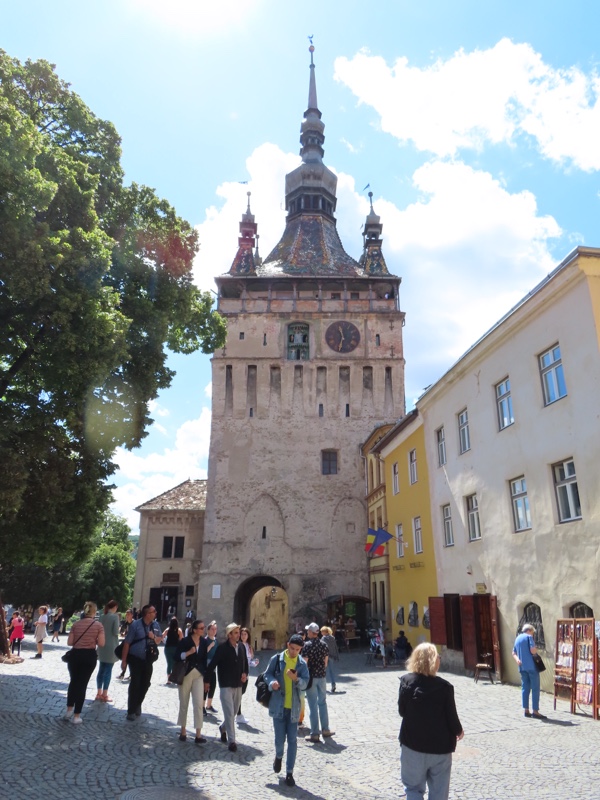
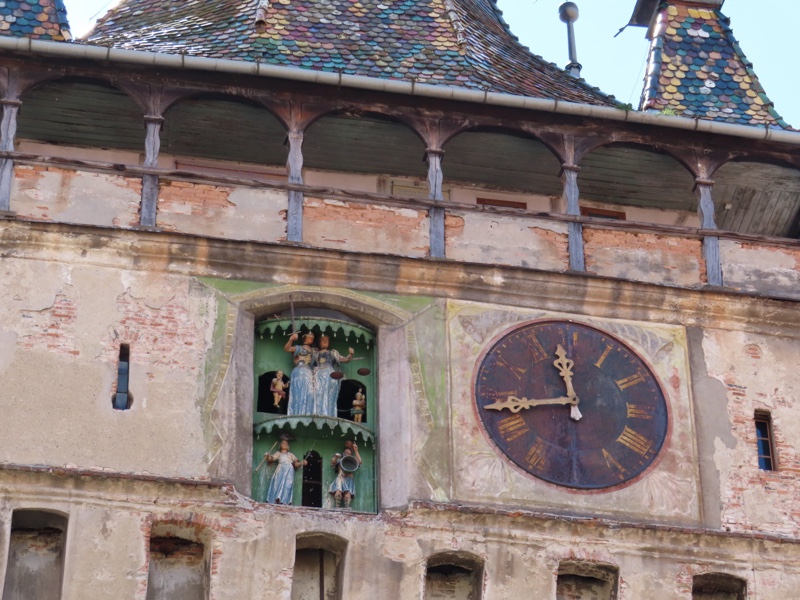
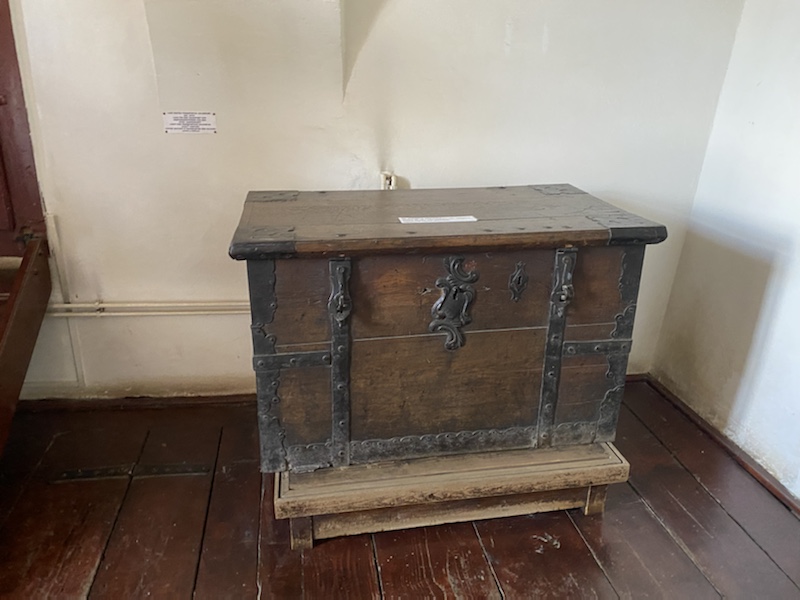
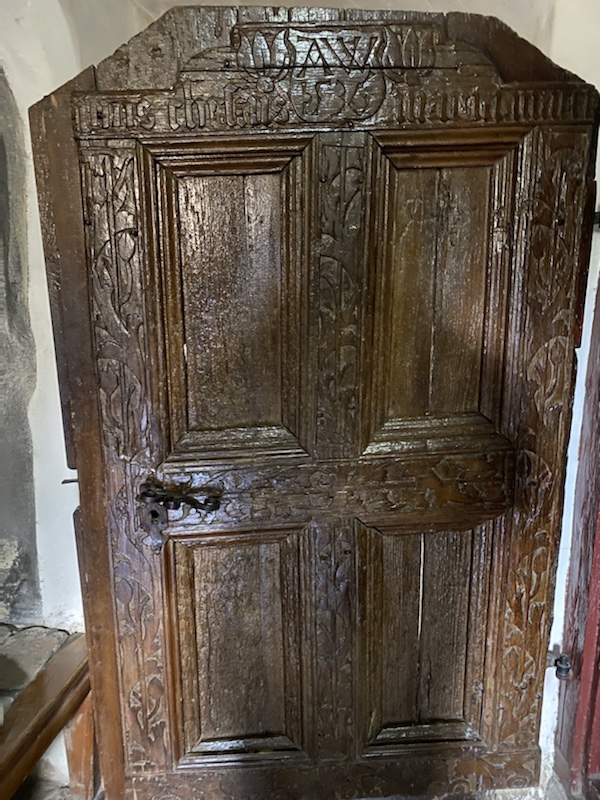


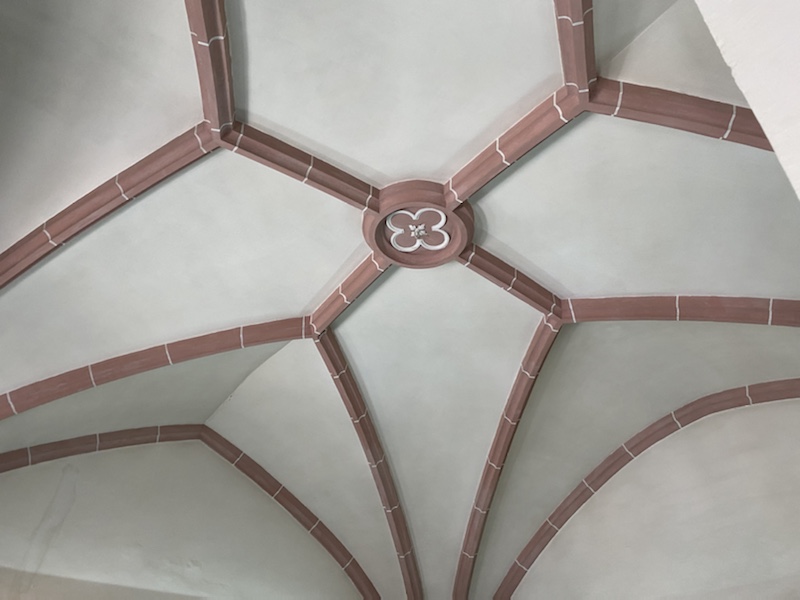
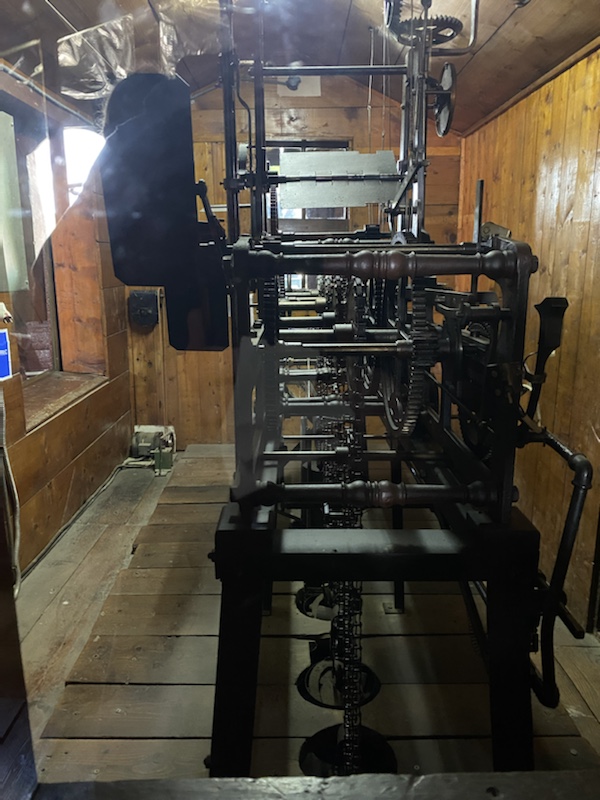

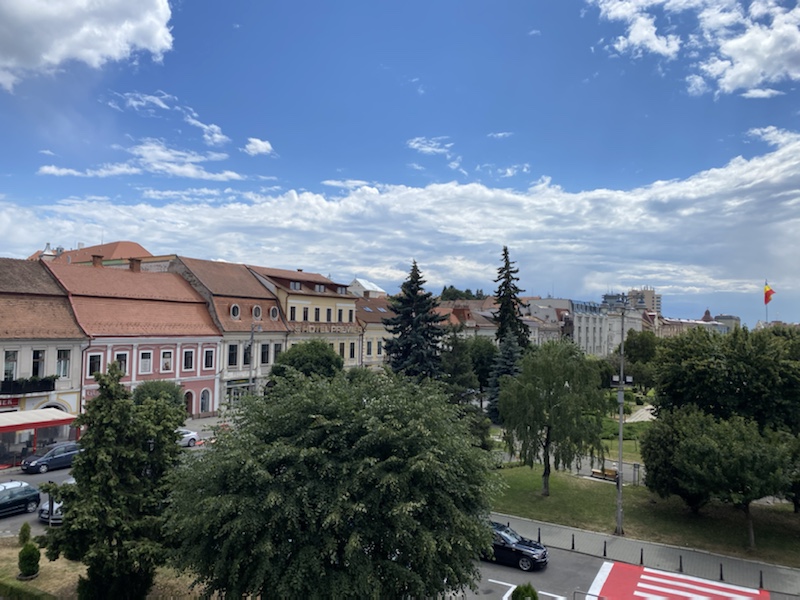

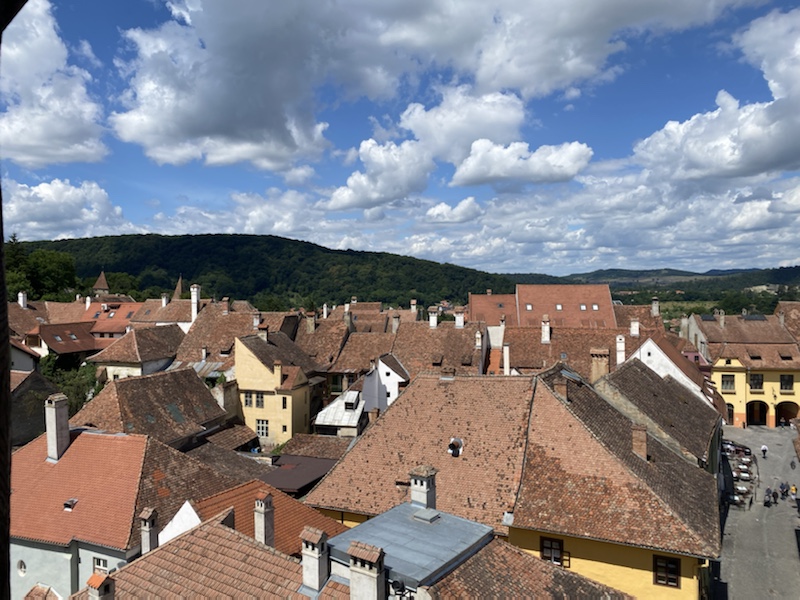
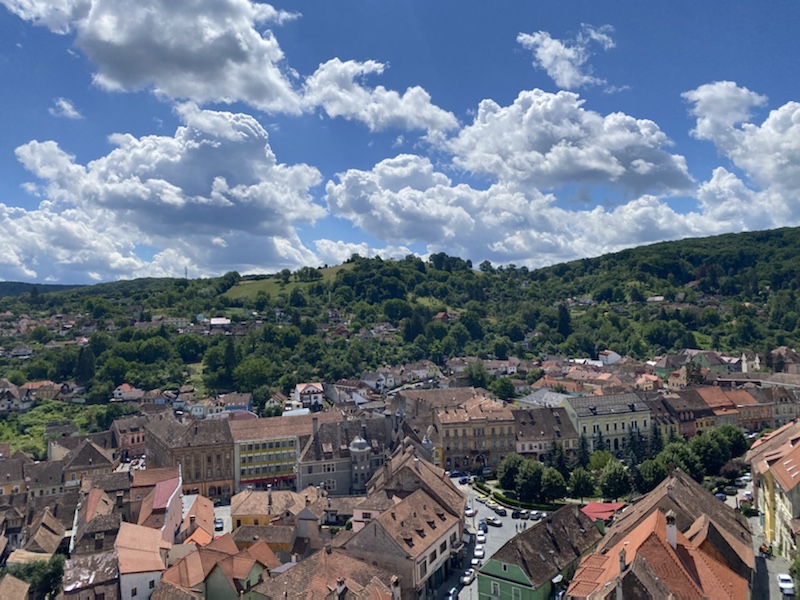


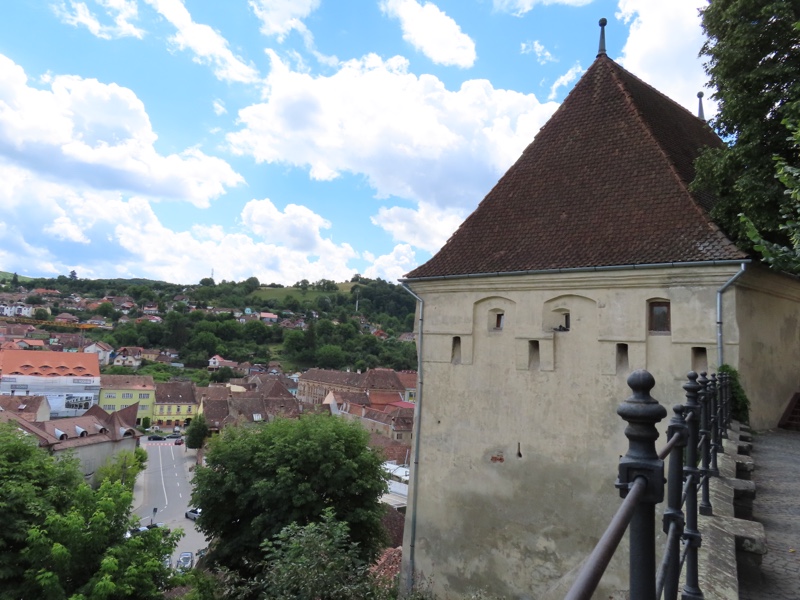
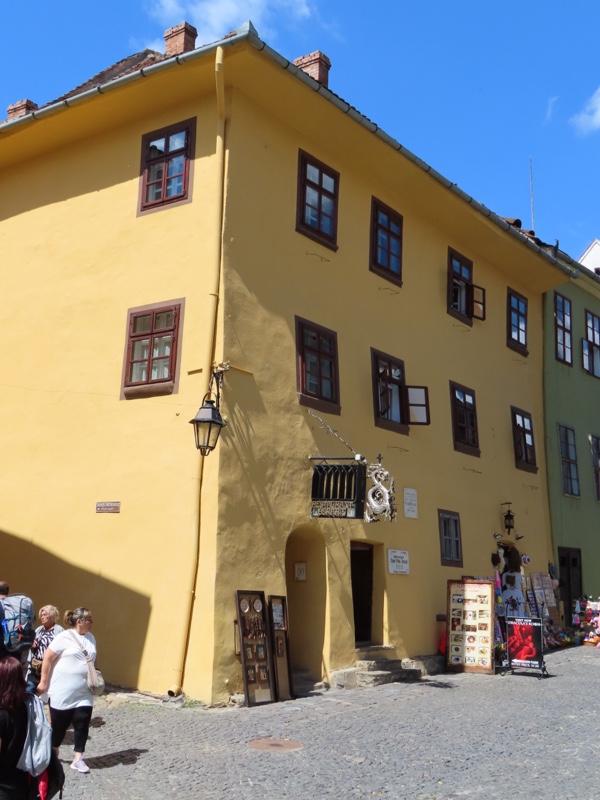
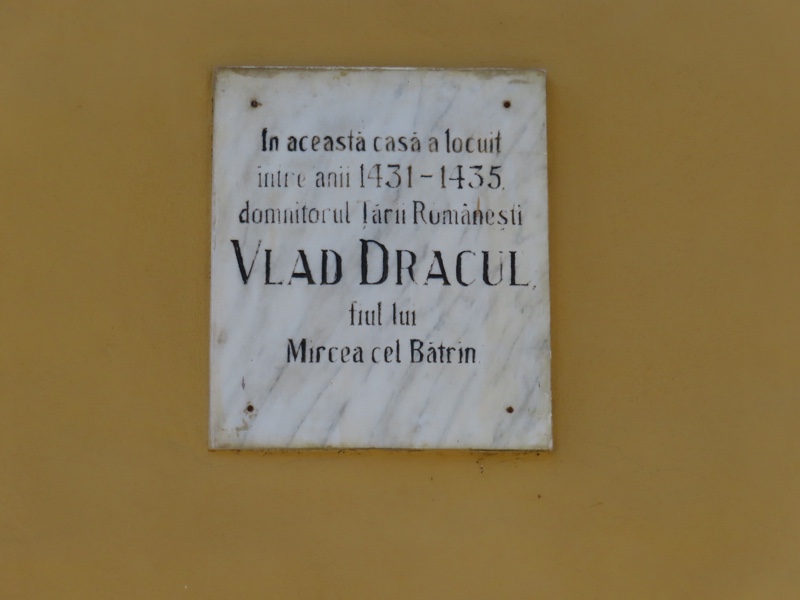





 That pink thing on the left is my Beretta baseball cap… I can’t imagine any soldier carrying this thing about.
That pink thing on the left is my Beretta baseball cap… I can’t imagine any soldier carrying this thing about.

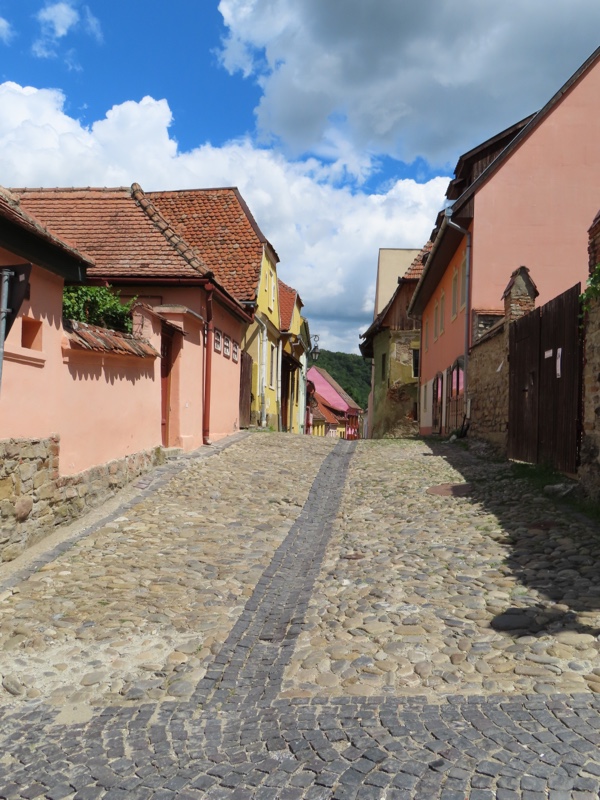



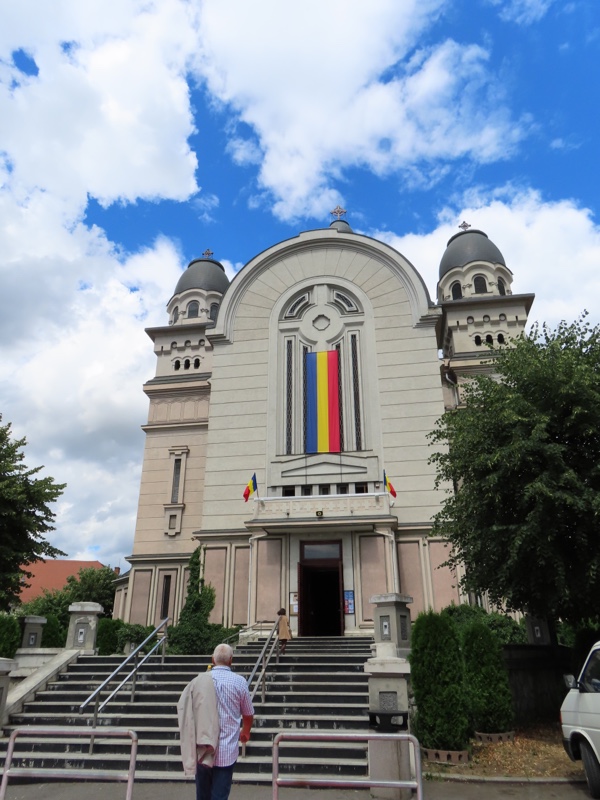 They call this the Ascension Cathedral, but it’s actually a church as it is under the purview of priest not a bishop. Construction started on it in 1925, and the frescos and murals were started in 1934. The gold iconostasis was completed in 1939, and then it turns out their plans were a little ambitious for this little town and they had to halt work on the frescoes when they ran out of money. Work eventually resumed they were apparently completed in 1986. The result is that some of the frescoes look 100 years old and are quite dark from age and incense smoke etc, and some look as bright as if they were done in the last few years.
They call this the Ascension Cathedral, but it’s actually a church as it is under the purview of priest not a bishop. Construction started on it in 1925, and the frescos and murals were started in 1934. The gold iconostasis was completed in 1939, and then it turns out their plans were a little ambitious for this little town and they had to halt work on the frescoes when they ran out of money. Work eventually resumed they were apparently completed in 1986. The result is that some of the frescoes look 100 years old and are quite dark from age and incense smoke etc, and some look as bright as if they were done in the last few years.
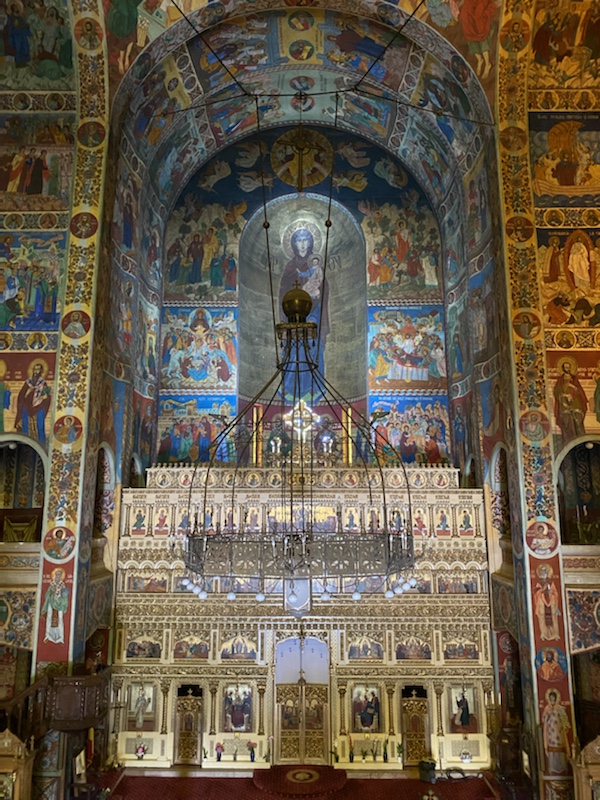

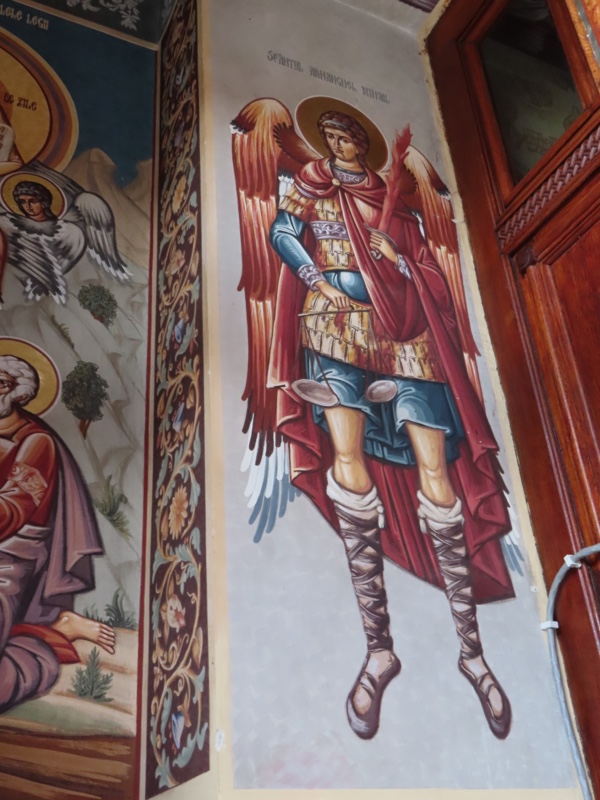



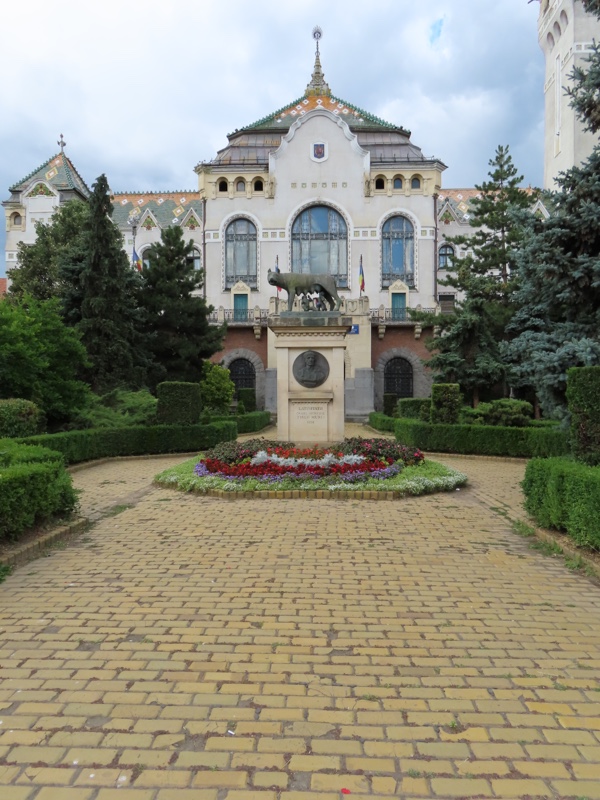 This is the Mayor’s residence, right next door to the Mayoral offices, and it seems the mayor who built it in the early 1900s was heavily into Italian/Latin architecture styles – which ends up in a weird mishmash of an Italian villa with a Romanian looking roof and decoration… I have no idea why Romulus and Remus are prominently out front – it’s a mystery?!
This is the Mayor’s residence, right next door to the Mayoral offices, and it seems the mayor who built it in the early 1900s was heavily into Italian/Latin architecture styles – which ends up in a weird mishmash of an Italian villa with a Romanian looking roof and decoration… I have no idea why Romulus and Remus are prominently out front – it’s a mystery?! 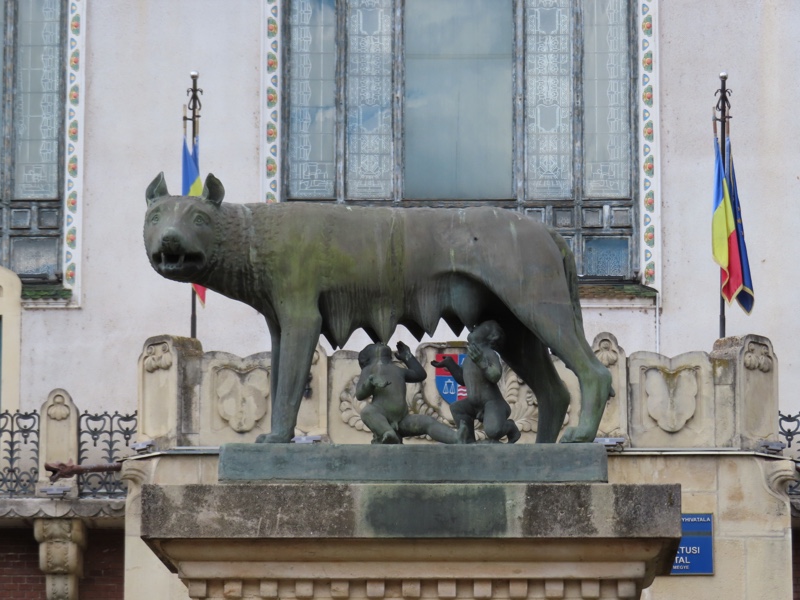 And here we remained while we waited for The Annoying American on our tour to finally deign to meet up with the group. Yes, there’s three American’s on our tour, and two of them are delightful – thoughtful, engaging and considerate beautiful humans… and one horrifically entitled, self involved fucking clueless inconsiderate c&%t!!! This person had lost her sunglasses the night before – left them on a table at a Greek restaurant in Brasov, and had been whining all fucking day about not being able to get hold of them to find them for her, ‘My gawd, they’re like, $400 sunglasses, like they should at least be able to find them and like, send them to me in Bucharest.’ When she wasn’t complaining to us about her lost sunglasses, she was skiving away from group trying to find some ‘decent’ sunglasses to buy. So, we had been playing ‘Oh-FFS-Where’s-The-Annoying-American’ all day. Now we were all hurried up and getting ready to leave and she is nowhere to be found. Not answering messages on the WhatsApp group chat and eventually, she replies saying she’s buying sunnies and found ‘gold on special’ (WTF?) and will be there soon. So the ten of us stand around on the footpath outside the Mayor’s house cursing her and waiting for her to turn up.
And here we remained while we waited for The Annoying American on our tour to finally deign to meet up with the group. Yes, there’s three American’s on our tour, and two of them are delightful – thoughtful, engaging and considerate beautiful humans… and one horrifically entitled, self involved fucking clueless inconsiderate c&%t!!! This person had lost her sunglasses the night before – left them on a table at a Greek restaurant in Brasov, and had been whining all fucking day about not being able to get hold of them to find them for her, ‘My gawd, they’re like, $400 sunglasses, like they should at least be able to find them and like, send them to me in Bucharest.’ When she wasn’t complaining to us about her lost sunglasses, she was skiving away from group trying to find some ‘decent’ sunglasses to buy. So, we had been playing ‘Oh-FFS-Where’s-The-Annoying-American’ all day. Now we were all hurried up and getting ready to leave and she is nowhere to be found. Not answering messages on the WhatsApp group chat and eventually, she replies saying she’s buying sunnies and found ‘gold on special’ (WTF?) and will be there soon. So the ten of us stand around on the footpath outside the Mayor’s house cursing her and waiting for her to turn up.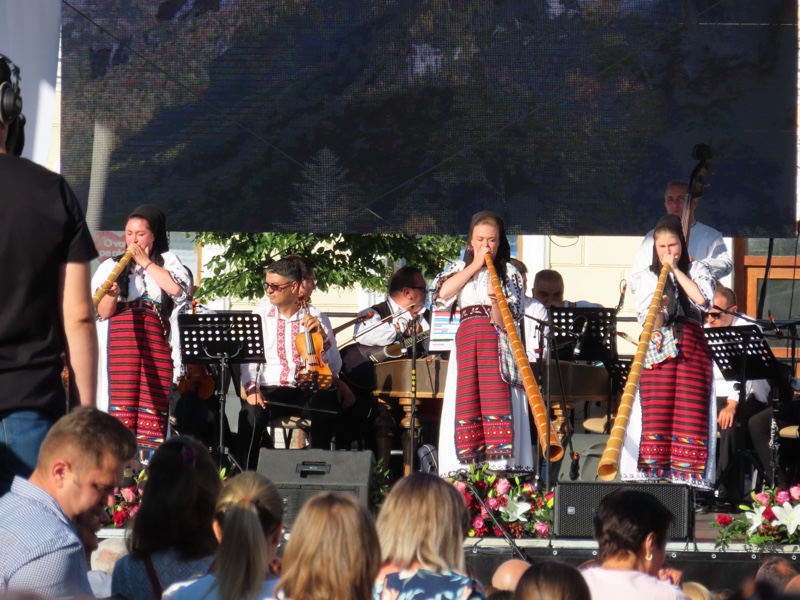 The square was full of locals out to enjoy the evening and the noise.
The square was full of locals out to enjoy the evening and the noise.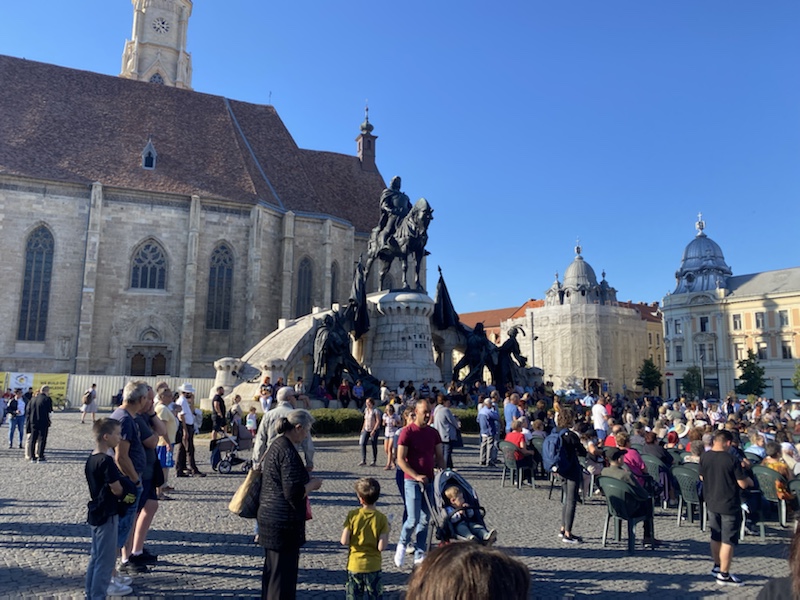 The Matthias Corvinus sculpture – you know, the guide didn’t tell me who he was or why there was a statue to him and I didn’t bother supplementing that for a change by googling it myself (which is another recurring theme lately), so this is him, but fucked if I know what he did to be worthy of a huge sculpture in the town square.
The Matthias Corvinus sculpture – you know, the guide didn’t tell me who he was or why there was a statue to him and I didn’t bother supplementing that for a change by googling it myself (which is another recurring theme lately), so this is him, but fucked if I know what he did to be worthy of a huge sculpture in the town square. Ok, I lied
Ok, I lied
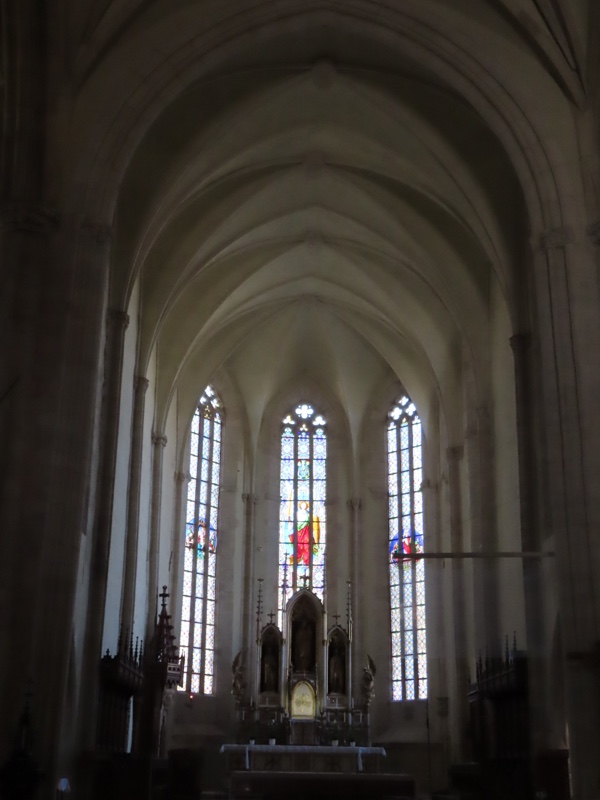

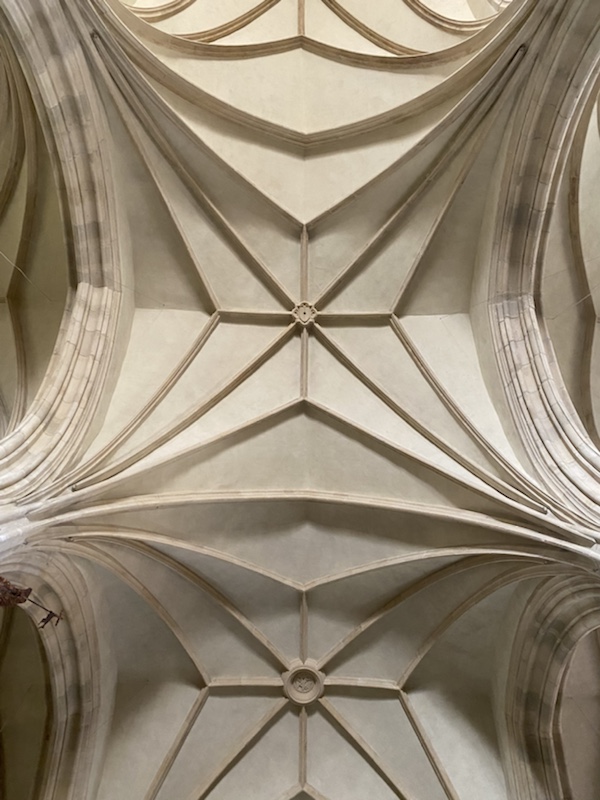
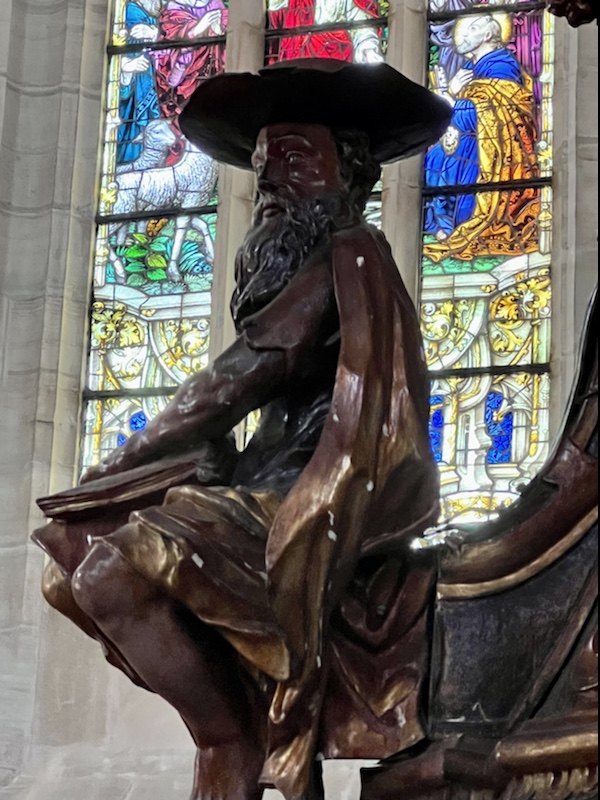


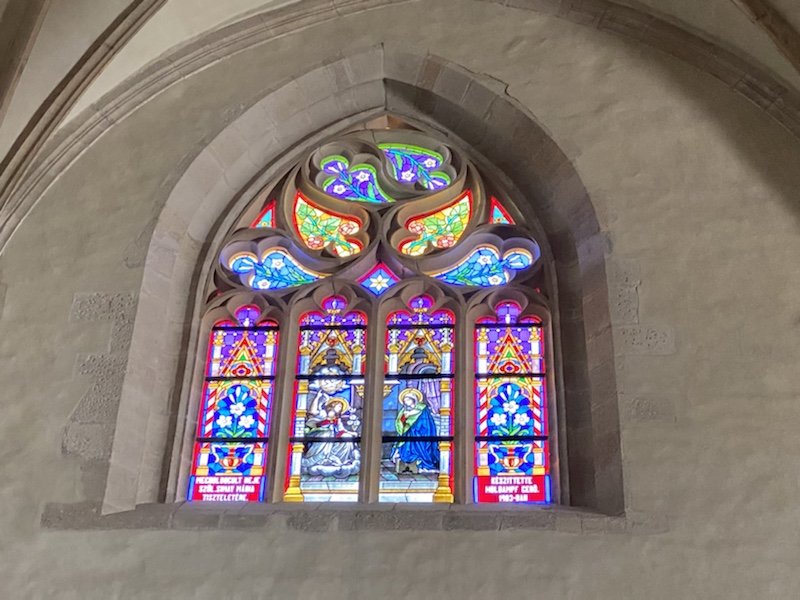

 After lunch we went to Bran Castle which is totally different from when I was here back in 1995… where there was a car park, there is now a little market village flogging all sorts of souvenirs and toys to tourists. Where the castle was a bit like touring someone’s English manor home it is now a full on tourist attraction complete with glass display cases and multi-language guide books.
After lunch we went to Bran Castle which is totally different from when I was here back in 1995… where there was a car park, there is now a little market village flogging all sorts of souvenirs and toys to tourists. Where the castle was a bit like touring someone’s English manor home it is now a full on tourist attraction complete with glass display cases and multi-language guide books.




























 The rugs were lining the walls above stalls (almost in place of stall plates), hanging from galleries and draped from baulstrades. They looked really out of place, but I guess that is because this is the only church I’ve ever seen that is collecting Ottoman rugs?!
The rugs were lining the walls above stalls (almost in place of stall plates), hanging from galleries and draped from baulstrades. They looked really out of place, but I guess that is because this is the only church I’ve ever seen that is collecting Ottoman rugs?!  These are some of the gravestones that used to be set into the church floor – burials under the church floor were a very popular tradition across numerous cultures, but these ones are carved in such deep relief, I imagine they would be quite the trip hazard.
These are some of the gravestones that used to be set into the church floor – burials under the church floor were a very popular tradition across numerous cultures, but these ones are carved in such deep relief, I imagine they would be quite the trip hazard. 


 We then went on the check out the main square in the centre of Brasov – lovely fountain, cute church, square lined with bistros and umbrellas for al fresco dining – and subsequently went hunting for a restaurant serving traditional Romanian food.
We then went on the check out the main square in the centre of Brasov – lovely fountain, cute church, square lined with bistros and umbrellas for al fresco dining – and subsequently went hunting for a restaurant serving traditional Romanian food.
 I ordered the Bulz, which is a polenta dish with a small layer of cheese with some ham and a fried egg on top, served baked in a ramekin. It was very tasty, but a little too salty for my liking so I only managed to have about half of it.
I ordered the Bulz, which is a polenta dish with a small layer of cheese with some ham and a fried egg on top, served baked in a ramekin. It was very tasty, but a little too salty for my liking so I only managed to have about half of it.  Angus had a lamb mici, which reminded me of a Turkish adana kebap but was pretty heavy on the rosemary and thyme. All very tasty and better than the pasta and wood fired pizza offerings that seem to be the flavour of the month in Romania dining.
Angus had a lamb mici, which reminded me of a Turkish adana kebap but was pretty heavy on the rosemary and thyme. All very tasty and better than the pasta and wood fired pizza offerings that seem to be the flavour of the month in Romania dining. 